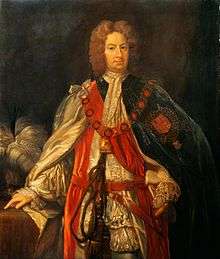James Graham, 1st Duke of Montrose
| The Duke of Montrose | |
|---|---|
 James Graham, 1st Duke of Montrose. | |
| Lord Keeper of the Great Seal of Scotland | |
|
In office 1716–1733 | |
| Monarch |
George I George II |
| Preceded by | The Marquess of Annandale |
| Succeeded by | The Earl of Ilay |
| Lord Clerk Register | |
|
In office 1716–1716 | |
| Monarch | George I |
| Secretary of State for Scotland | |
|
In office 24 September 1714 – August 1715 (resigned) | |
| Monarch | George I |
| Keeper of the Privy Seal of Scotland | |
|
In office 1709–1713 | |
| Monarch | Queen Anne |
| Lord President of the Council of Scotland | |
|
In office 1706–1707 | |
| Monarch | Queen Anne |
| Lord High Admiral of Scotland | |
|
In office 1705–1706 | |
| Monarch | Queen Anne |
| Lord President of the Council of Scotland | |
|
In office 1704–1705 | |
| Monarch | Queen Anne |
| Personal details | |
| Born |
April 1682 Scotland |
| Died |
7 January 1742 (aged 59) London, England, Great Britain |
| Spouse(s) | Christian Carnegie |
| Children |
4 sons 1 daughter |
James Graham, 1st Duke and 4th Marquess of Montrose (April 1682 – 7 January 1742) was a Scottish aristocratic statesman in the early eighteenth century.
Life
He was the only son of James Graham, 3rd Marquess of Montrose and Lady Christian Leslie. On 31 March 1702 he married Christian Carnegie, daughter of David Carnegie, 3rd Earl of Northesk. Together they had several sons, including William Graham and Lord George Graham.[1]
Originally the fourth Marquess of Montrose, James was elevated to a dukedom in 1707, as a reward for his important support of the Act of Union, whilst being Lord President of the Scottish Privy Council. He was Lord High Admiral of Scotland from 1705 to 1706. He was Keeper of the Privy Seal of Scotland from 1709 to 1713 and served as Keeper of the Great Seal of Scotland from 1716 to 1733. He was also a Lord of the Regency for Great Britain in 1714, upon the death of Queen Anne. Furthermore, he served rather shortly as Secretary of State for Scotland at the time of the Georgian ministry of Lord Townshend. In 1719 he was one of the main subscribers to the Royal Academy of Music (1719), a corporation that produced baroque opera on the stage. He served as a Governor of London's Foundling Hospital at the time of its foundation in 1739. For much of his adult life he was Chancellor of the University of Glasgow.
Apart from his political career, the Duke is frequently associated with Robert MacGregor, who is popularly remembered by the name of Rob Roy.
On his death he was buried at Aberuthven.[2] The grave is within a substantial Palladian style mausoleum, which dominates the small churchyard.
In popular culture
In Michael Caton-Jones's Rob Roy, Graham is played by John Hurt.
Ancestry
| Ancestors of James Graham, 1st Duke of Montrose | ||||||||||||||||||||||||||||||||||||||||||||||||||||||||||||||||||||||||||||||||||||||||||||||||||||||||||||||||||||||||||||||||||||||||||||||||||||||||||||||||||||||||||||||||||||||||||||||||||||||||||||||||||||||||||||||||||||||||||||||||||||||||||||||||||||||||||||||||||||||||||||||||||||||||||||||||||||||||||||||||||||||||||||||||||||||||||||||||||||||||||||||||||||||||||||||||||||||||||||||||||||||||||||||||||||||||||||||||||||||||||||||||||||||||||||||||||||||||||||||||||||||||||||||||||||||||||||||||||
|---|---|---|---|---|---|---|---|---|---|---|---|---|---|---|---|---|---|---|---|---|---|---|---|---|---|---|---|---|---|---|---|---|---|---|---|---|---|---|---|---|---|---|---|---|---|---|---|---|---|---|---|---|---|---|---|---|---|---|---|---|---|---|---|---|---|---|---|---|---|---|---|---|---|---|---|---|---|---|---|---|---|---|---|---|---|---|---|---|---|---|---|---|---|---|---|---|---|---|---|---|---|---|---|---|---|---|---|---|---|---|---|---|---|---|---|---|---|---|---|---|---|---|---|---|---|---|---|---|---|---|---|---|---|---|---|---|---|---|---|---|---|---|---|---|---|---|---|---|---|---|---|---|---|---|---|---|---|---|---|---|---|---|---|---|---|---|---|---|---|---|---|---|---|---|---|---|---|---|---|---|---|---|---|---|---|---|---|---|---|---|---|---|---|---|---|---|---|---|---|---|---|---|---|---|---|---|---|---|---|---|---|---|---|---|---|---|---|---|---|---|---|---|---|---|---|---|---|---|---|---|---|---|---|---|---|---|---|---|---|---|---|---|---|---|---|---|---|---|---|---|---|---|---|---|---|---|---|---|---|---|---|---|---|---|---|---|---|---|---|---|---|---|---|---|---|---|---|---|---|---|---|---|---|---|---|---|---|---|---|---|---|---|---|---|---|---|---|---|---|---|---|---|---|---|---|---|---|---|---|---|---|---|---|---|---|---|---|---|---|---|---|---|---|---|---|---|---|---|---|---|---|---|---|---|---|---|---|---|---|---|---|---|---|---|---|---|---|---|---|---|---|---|---|---|---|---|---|---|---|---|---|---|---|---|---|---|---|---|---|---|---|---|---|---|---|---|---|---|---|---|---|---|---|---|---|---|---|---|---|---|---|---|---|---|---|---|---|---|---|---|---|---|---|---|---|---|---|---|---|---|---|---|---|---|---|---|---|---|---|---|---|---|---|---|---|---|---|---|---|---|---|---|---|---|---|---|---|---|---|---|---|---|---|---|---|---|---|---|---|---|---|---|---|---|---|---|---|---|---|---|---|---|---|---|---|---|---|---|---|---|---|---|---|---|---|---|---|---|---|---|---|---|---|---|---|---|---|---|---|---|---|---|---|---|---|---|---|---|---|---|---|---|---|---|---|---|---|---|---|---|---|---|---|---|
| ||||||||||||||||||||||||||||||||||||||||||||||||||||||||||||||||||||||||||||||||||||||||||||||||||||||||||||||||||||||||||||||||||||||||||||||||||||||||||||||||||||||||||||||||||||||||||||||||||||||||||||||||||||||||||||||||||||||||||||||||||||||||||||||||||||||||||||||||||||||||||||||||||||||||||||||||||||||||||||||||||||||||||||||||||||||||||||||||||||||||||||||||||||||||||||||||||||||||||||||||||||||||||||||||||||||||||||||||||||||||||||||||||||||||||||||||||||||||||||||||||||||||||||||||||||||||||||||||||
References
- ↑ "James Graham, 1st Duke of Montrose". thepeerage.com. Retrieved 9 September 2012.
- ↑ "Graham; James (c 1680 - 1742); 1st Duke of Montrose". The Royal Society. Retrieved 9 September 2012.(subscription required)
 Stephen, Leslie; Lee, Sidney, eds. (1890). "Graham, James (d.1742)". Dictionary of National Biography. 22. London: Smith, Elder & Co.
Stephen, Leslie; Lee, Sidney, eds. (1890). "Graham, James (d.1742)". Dictionary of National Biography. 22. London: Smith, Elder & Co.